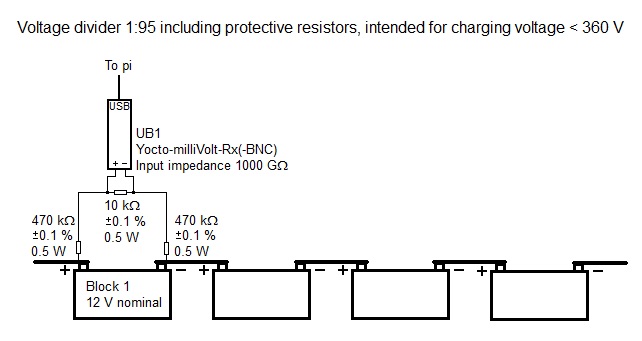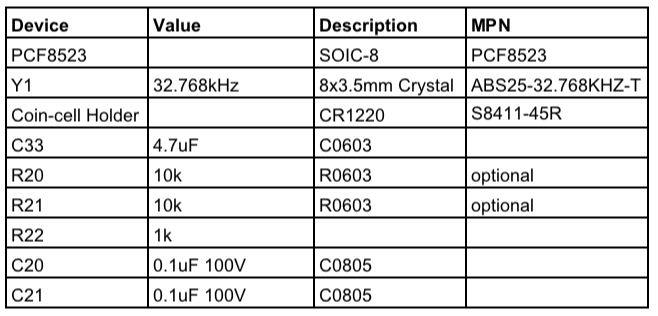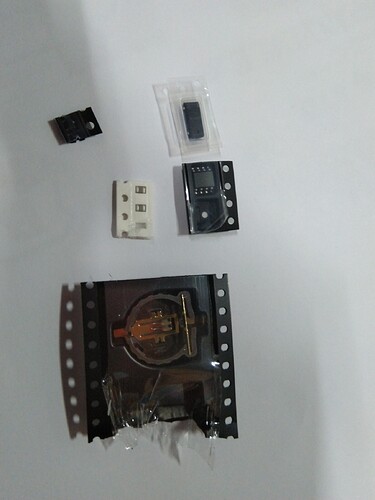Just a note that Trystan is going to merge other emonDC related threads… There’s going to be a reshuffle. We’re going to make it make sense and hopefully easier to read!
Our company TEROC has used Emoncms for a couple applications with DC. One project is a house using a 760 V DC nanogrid, where the plan is to integrate V2H. The House Unplugged software used there is available as open-source on TEROC. In that project, a Wago PLC sends data to Emoncms. Another project available as open-source on our web site is a battery bank monitor, which can run on for example a Raspberry Pi. Perhaps emonDC would be an alternative to the Yoctopuce sensors that we are using for that? We are planning to use Emoncms for other related applications too.
Hi Sven,
I had a look at the ThorBatteryMonitor project including the Yoctopuce sensors and found this diagram.

emonDCduo could perform this function. If the added safety of the external resistors was appealling this would also be possible. It’d need some planning.
I think emonDCduo could be capable of monitoring two sets of 12V battery, as it is dual channel. The negative-most connection would be the battery/emonDC GND, and positive most around the 24V mark. Each channel could take 50% of the sensing range.
The data could then be transmitted safely over WiFi.
At the moment the ESP12 module means each unit consumes around 65mA, this can be powered from the battery locally with a buck regulator, or from an external 5V source (perhaps with isolation in mind).
It can post directly to emonCMS using a modified version of emonESP I’m working on.
At present, I build the units to order.
Cheers,
Dan
Hi Daniel,
Glad to hear that you think emonDCduo could work. Can you say anything regarding the impedance of the measurement inputs on emonDCduo?
Sven
This would be determined by the shunt monitor selection. The MAX9918 datasheet says 300kOhm.
If you don’t need shunt monitors, so we’re only monitoring voltage, then the input impedance would be closer to 1MOhm, as set by the voltage divider ‘Vsense’ circuit.
Hi all,
Am very new with Open energy, but have happily been able to make it work with home off-grid system 24V 3000W.
My issue is that i’ve buy the DC-DC kit unsolder version and the RTC ( Real time closck) unsolder version.
- The DC-DC kit does not work after having been able to solder all parts without notice
- Could someone help for soldering of the RTC. Any documentation.
After replacing the provided DC-DC kit with a chinese one, all work.
The amp reading on the external shunt is not accurate at high amp consumption ( around 90 to 110 amp) any documentation on amp calibration.
Hi Giles, welcome.
I think I remember putting together your order.
Firstly, the unit is not strictly rated for those amperages continuously. I2R = (110*110)*0.0005 = 6W.
Can you tell me which shunts you had? If they were the 0.5mOhm ones rated at 6W you could use them for short periods of high Amps. With current shunts, it’s best keep 2 or 3 times below the rating.
I’ve not developed anything useful in the firmware for the RTC yet. I can refund you the RTC parts, I could remove it from the shop to be honest. The data will have to get timestamped on arrival to emonCMS. I’m sorry I can’t be of more help right now.
Calibration is done either in emonCMS or by reflashing the unit, using a UART adaptor.
Did you use the bill of materials sheet for soldering the DC-DC module?
It’s possible you will need to solder in the voltage sense input resistors. Can you check if R1 and R2 are present on the board?
Hi Daniel,
Thanks a lot for your support.
The shunt a is a 500 amp 75mv, i’ve remove it from an old Chinese wireless volt/watt meter. Heavy load of max 90~110amp may be around 4 to 6 minute. Its not continuous, my normal load is 20 ~ 30 amp continuous. I will post photo of the shunt and my system.
For the RTC. i think that it will be an important need, ive also notice that the data capture is not properly recorded during the day. In few occasion the wifi module will stay offline and no information will be posted to CMS during this period despite the Memory card.
I think that calibration will be a must by reflashing. ( I will have do note more home work for this )
For the DC-DC yes, i’ve use all parts provided. there is more parts compare to the one you posted. Only R1 was already solder on the kit.
So is that 1.8W dissipated at 110A? The rating is 0.075*500 = 37.5W ?! … Must be a peak-power rating only.
Looks like C1 is missing. Did you find a suitable replacement?
I agree an RTC is important for this kind of system.
If reflashing you might know you need to be aware of any ground-potential difference that may exist between your DC system and laptop. Might be worth disconnecting the DC system first, or running a laptop on its battery while flashing.
Hi Daniel,
For the DC-DC, yes got another C1, but same issue. In the meantime here the DC-DC i’ve got. All good for the moment.
Will be a good thing to incorporate the RTC, got lot of missing data.
One question please, does the module record data on the Memory card, how to check if it is working.
Try adjusting R2 until it comes on. It’s the under-voltage lockout, and may not be set to come on for your voltage.
I’ll check the version of the firmware you had and get back to you on that.
I’ve got good news and bad news.
The bad news: SD card writing isn’t working.
The good news: The RTC is now implemented, easier than I thought. The behaviour is thus -
- If network is not available, RTC will be initialised with the firmware compile date and time.
- If network is available, time will be had from NTP server and copied to the RTC regularly.
- If network drops (but device continuously powered) RTC time will continue to update.
- (untested) If device is unpowered, RTC time is lost, unless the backup battery is installed.
Time is passed in the JSON to emonCMS.
my skills must’ve developed during the most recent project…
The SD card writing implementation might be easier by now also… It was clashing with the ESP8266’s file-system before.
Have you flashed firmware with a UART adaptor before? Windows/Linux?
Hello Daniel,
Good news i can Say.
I’ve UART adapter, am ok with flashing on Windows. No issue on this side.
For soldering of RTC, could you help on placement of the provided RTC parts on the board.
This weekend i’ve notice that when there is a lot of activity on my home wifi, the module will not upload / record data, discontinue communication.
During a workday when nobody at home and no wifi activity. emonDC module will stay connected and you get instant/realtime data.
I see. Thanks for the information. There’s a world of WiFi I don’t understand, the ESP8266 will have it’s own ways also.
I’ve put a 433MHz radio module on the new revision of the board to provide the wireless option apart from WiFi, because of WiFi reliability (changing network SSID, passwords, network issues).
If the underside of your board looks like this:
then the BoM would be:

I’ve got something compiling for the SD card, I’ll test it and let you know how it goes. Could have SD card logging soon if it works.
Don’t overthink ESP8266 wifi - the libraries handle errors and re-connection. You can get into a big mess if you think you need to do this yourself. There are plenty of good resources around to show how to set things up.
Simon
That’s it, came to same conclusion. I’ve considered there’ll be a way to update the core of emonESP some time which may help or add features, but I’m not touching the inner workings.
I have the SD card working now too.
I’ll test overnight and confirm it’s working tomorrow.
You finally achieve the goal.
Good.
Here picture of RTC part received.
-PCF8523
-Coin-cell holder
-Y1
-C20
-C21
- A transistor ( I think ) ( Left top part ) Don’t know where to place it on the board.
Note the transistor which is not on the list. Is it important, no need to solder it. I cant find its location on the part.
And what about other part you listed, not received in the kit. Shall i need to add them or optional.
- C33 - 4.7uF
- R20 - 10K
- R21 - 10K
- R22 - 1K





